Seeing both the abs and traction control light on your dashboard can be alarming. These warning lights indicate that there may be an issue with two of your vehicle’s key safety systems, and it’s essential to understand what these lights mean and what steps to take when they come on.

What Do the ABS and Traction Control Lights Mean?
The ABS and traction control systems are closely related in modern vehicles. The ABS prevents your wheels from locking up during heavy braking, while the traction control system helps prevent wheel spin during acceleration, especially on slippery surfaces. When both lights come on, it typically indicates a malfunction in one or both systems.
Common Causes of ABS and Traction Control Lights Turning On
- Faulty Wheel Speed Sensors: Both the ABS and traction control systems rely on wheel speed sensors to monitor the rotation of each wheel. If one or more sensors are dirty, damaged, or fail, they can send incorrect signals to the control units, triggering both lights on your dashboard.
- Wiring Issues: Electrical problems, such as damaged or corroded wiring, can disrupt communication between the wheel speed sensors and the control units for the ABS and traction control systems. This can cause both lights to come on simultaneously.
- Malfunctioning ABS Module: The ABS module is responsible for processing information from the wheel speed sensors and managing the braking force to prevent wheel lockup. If the module fails, it can cause the ABS and traction control lights to illuminate.
- Low Brake Fluid Levels: The ABS relies on hydraulic pressure from the brake fluid to function correctly. Low brake fluid can reduce the system’s effectiveness, leading to the ABS light turning on, which can also affect the traction control system.
- Traction Control Module Failure: The traction control system has its own control module that works in conjunction with the ABS. A failure in the traction control module can cause both the ABS and traction control lights to turn on.
Steps to Take When ABS and Traction Control Lights Come On
- Check the Brake Fluid Level: The first step is to check your vehicle’s brake fluid level. If it’s low, top it off with the recommended type of brake fluid. If the fluid level drops frequently, it may indicate a leak that needs to be repaired.
- Inspect the Wheel Speed Sensors: If you’re comfortable with basic car maintenance, you can inspect the wheel speed sensors for any visible dirt, debris, or damage. Cleaning the sensors or replacing a faulty one may resolve the issue.
- Examine the Wiring: Look for any signs of damaged or corroded wiring, particularly around the wheel speed sensors. Electrical issues can often cause both the ABS and traction control lights to come on.
- Consult a Professional Mechanic: If you’re unable to identify or fix the issue, it’s best to take your vehicle to a professional mechanic. They can run a diagnostic scan to determine the exact cause of the problem and recommend the appropriate repairs.
- Drive Cautiously: While your vehicle’s basic braking system will still function with the ABS and traction control lights on, these systems are important for maintaining control in difficult driving conditions. Drive cautiously, especially on wet or icy roads, until the issue is resolved.
Why You Shouldn’t Ignore the ABS and Traction Control Lights
Both the ABS and traction control systems are essential for maintaining safety and control while driving. Ignoring these warning lights can lead to increased risks, particularly in poor weather conditions. Without a functioning ABS, your vehicle is more likely to skid during emergency braking, and without traction control, you may experience wheel spin during acceleration.
Additionally, driving with these lights on for an extended period can cause further damage to your vehicle’s braking and traction systems, leading to more costly repairs down the road.
Conclusion
The ABS and traction control light on your dashboard are important warning signs that should not be ignored. Whether the issue is as simple as a faulty sensor or something more complex like a module failure, addressing it promptly will help ensure your vehicle remains safe to drive. If you see both lights on, take the necessary steps to diagnose and fix the problem, or consult a professional mechanic to ensure your safety on the road.